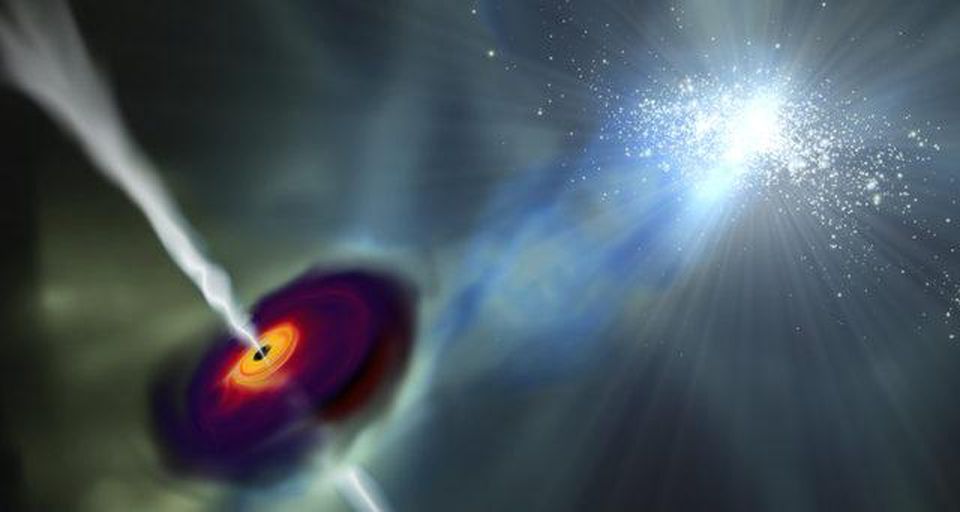 Black holes themselves are not visible, but X-rays and radio emissions from matter near them can give us an idea of their location and physical properties.
Black holes themselves are not visible, but X-rays and radio emissions from matter near them can give us an idea of their location and physical properties.In the center of almost every galaxy there is a supermassive black hole, at the location of which matter has accumulated weighing millions or even billions of suns. However, around it should be not only a lot of fast moving stars, but also tens of thousands of smaller black holes formed from the remains of massive stars that were supposed to be near the galactic center. Observing the space around
Sagittarius A * , our monster in the center of the Milky Way weighing four million solar, we found stars, dust, gas, electromagnetic radiation, and everything that we expected, with one exception: no evidence of the presence of these black holes of a smaller size. It was expected that in the region with a diameter of only six light-years and a center in Sagittarius A * there are more than ten thousand, but they were not there. That is, until we have come up with a new clever method, thanks to which in just one last year we have already found ten of them. From this it follows that these black holes are really there, and now we have an idea about how to find them.
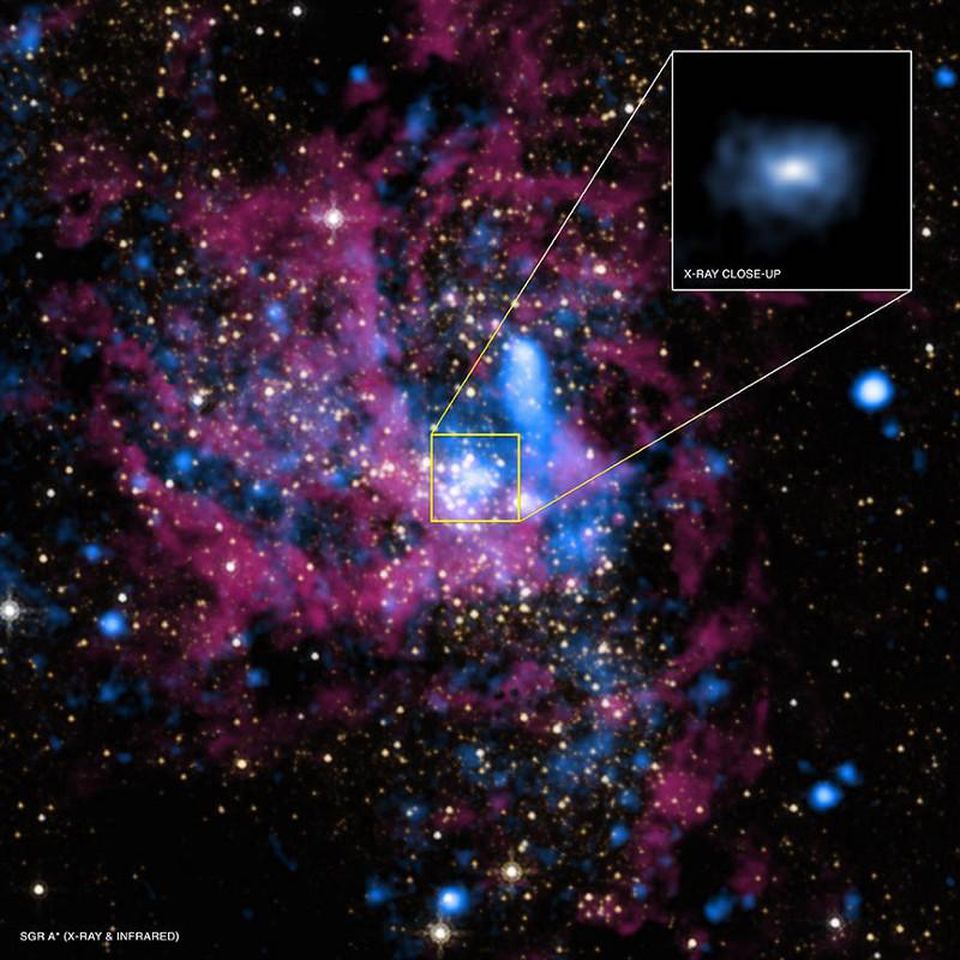 Composite image of a black hole in the center of our galaxy from X-rays and infrared rays: Sagittarius A *. Its mass is four million solar, and it is surrounded by hot gas, emitting x-rays, stars, and, potentially, many thousands of smaller black holes.
Composite image of a black hole in the center of our galaxy from X-rays and infrared rays: Sagittarius A *. Its mass is four million solar, and it is surrounded by hot gas, emitting x-rays, stars, and, potentially, many thousands of smaller black holes.The region of space surrounding the black hole in the center of our galaxy is filled with material that can be detected only outside the visible spectrum. Although there is no doubt there are many stellar sources of light, the dust that fills the plane of our Milky Way, is enough to block all the light that would otherwise pass 25,000 light-years to reach our eyes. But at long wavelengths, in the infrared and radio wavelengths, there is light that can penetrate to us and reveal the presence of stars and gas in the center, and X-rays at shorter wavelengths can give us a wealth of information about energy sources of radiation and events occurring there. .
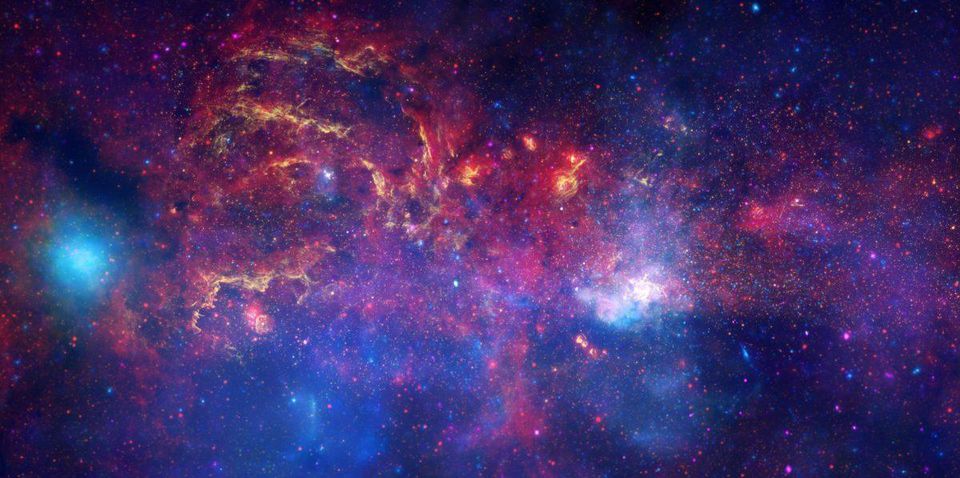 The image of the galactic center in the light of different wavelengths shows stars, gas, radiation and black holes, as well as other sources. But the light coming from them all, from gamma rays to visible light and radio waves, can only say that they are able to catch our instruments at a distance of over 25,000 light years.
The image of the galactic center in the light of different wavelengths shows stars, gas, radiation and black holes, as well as other sources. But the light coming from them all, from gamma rays to visible light and radio waves, can only say that they are able to catch our instruments at a distance of over 25,000 light years.When we study the space surrounding Sagittarius A *, we see a large number of stars moving around the central black hole, as well as periodic flashes arising in the process of absorption by the black hole of various lumps of matter. From what we see, one can imagine what this region of space is like: it is full of matter, capable of actively creating stars, and rich in heavy elements. The gas and dust present there create an ideal environment for the active formation of stars, which, as our best theories say, is happening there. There should be formed many stars with a large variety of masses, from which a rather large number of supernovae, neutron stars and black holes should be obtained. It is from these data that we estimate that within a radius of three light years from Sagittarius A * there should be about 10,000–20,000 black holes.
 A whole crowd of stars was found next to a supermassive black hole in the core of the Milky Way. In addition to these stars, gas and dust, we expect that in this region there will be at least 10,000 black holes located just a few light years from Strelets A *, but so far it has been rather difficult to find them.
A whole crowd of stars was found next to a supermassive black hole in the core of the Milky Way. In addition to these stars, gas and dust, we expect that in this region there will be at least 10,000 black holes located just a few light years from Strelets A *, but so far it has been rather difficult to find them.But, despite the prediction, we have problems observing these black holes. And there is a convincing reason: most of them are difficult to observe, because they do not emit radiation, which we could catch. To detect isolated black holes that were the only stars in their system, we do not have a working method. But to see black holes that exist in binary systems in which a black hole and a star move around each other, there is a tricky way: we are looking for bright flashes of x-rays emitted by such systems.
According to astrophysicist Chuck Haley :
This is the obvious way to search for black holes. But the
galactic center is so far from the Earth that such flashes are strong enough and bright enough for us to see them only once every 100 - 1000 years.
And since we were not lucky yet, we needed another method.
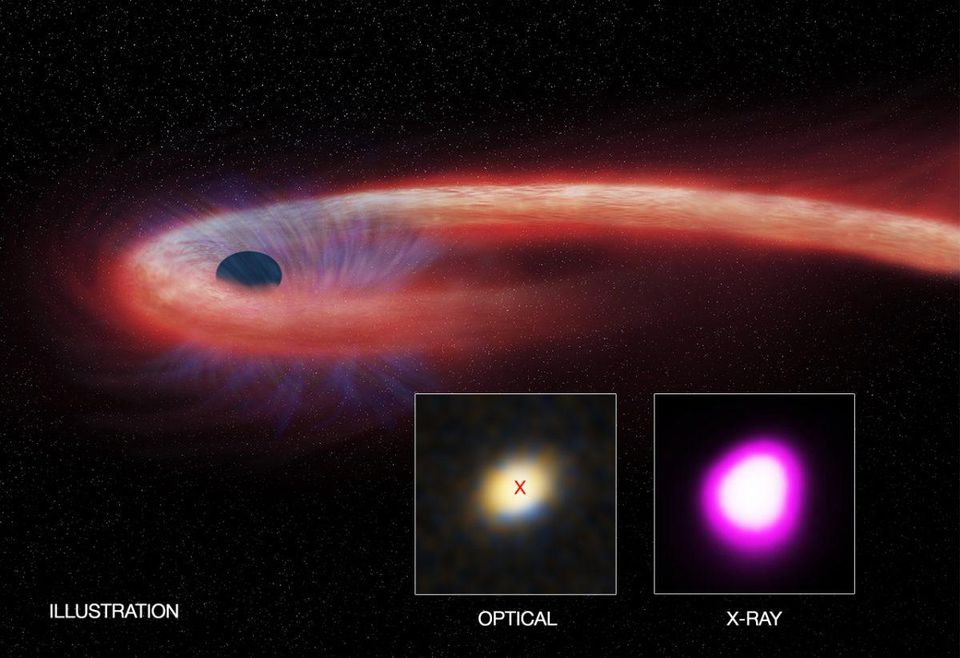 The black hole is known for absorbing matter and has an event horizon from which nothing can escape. But off the horizon, it can emit x-rays. It can go both in the form of large flashes, and in the form of a constant, relatively quiet stream, arising due to the slow eating of the BH neighbor
The black hole is known for absorbing matter and has an event horizon from which nothing can escape. But off the horizon, it can emit x-rays. It can go both in the form of large flashes, and in the form of a constant, relatively quiet stream, arising due to the slow eating of the BH neighborIt was at that moment that the Haley team came to the rescue. Instead of searching for a binary system with a star and a black hole in an active state characterized by flashes, they realized that they could look for traces of less energetic X-ray waves that should have existed during the inactivity of these systems. Haley continues:
Everything would be simple if black systems with a black hole would constantly emit powerful flares, as binary systems with a neutron star do, but this is not so, so we had to invent another way to find them. When a black hole approaches a low-mass star, this partnership emits x-ray flashes, which are weaker, but they are constant and can be detected.
It would take a lot of time to track such effects in the galactic center in the X-ray range, and without a clearly stated goal such a project would not have been approved. But Hayley’s team had a trump card: such data existed thanks to
the Chandra X-ray Observatory .
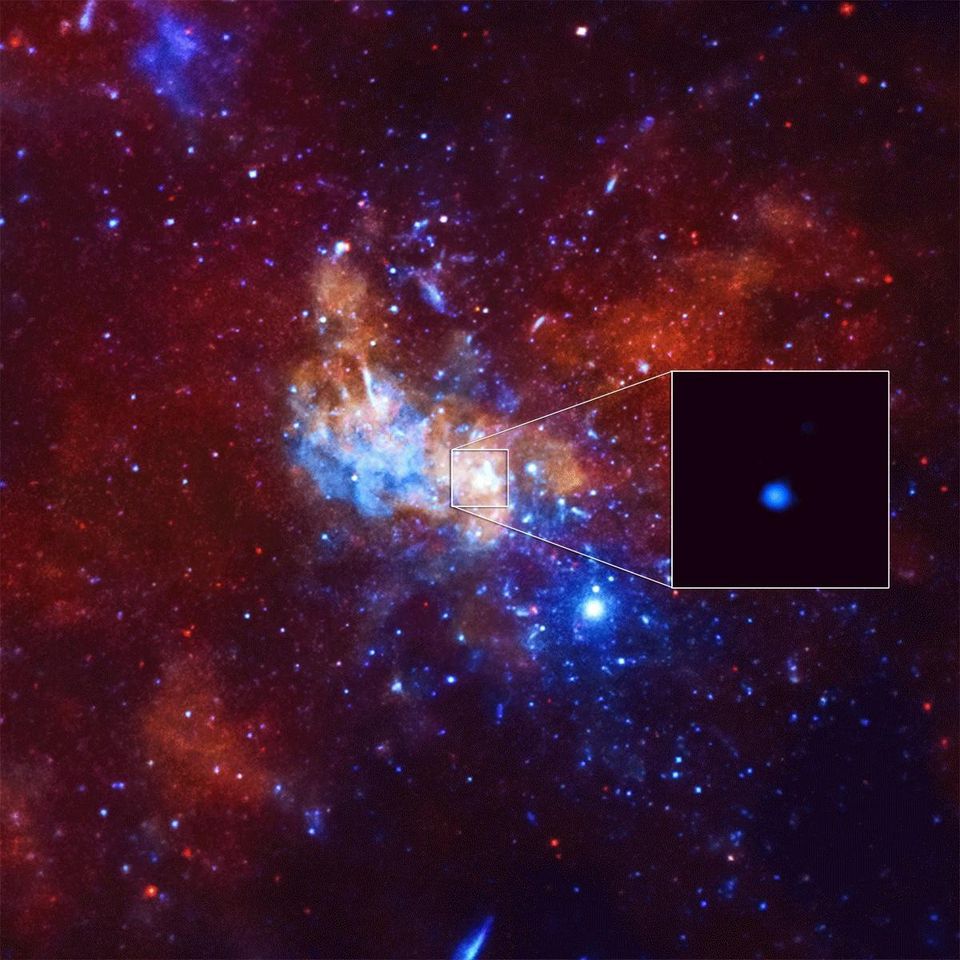 The supermassive black hole of our galaxy witnessed extremely bright flares, but none of them were as bright or long as XJ1500 + 0134. Due to such events, Chandra gathered a huge amount of data for 19 years of observations of the galactic center.
The supermassive black hole of our galaxy witnessed extremely bright flares, but none of them were as bright or long as XJ1500 + 0134. Due to such events, Chandra gathered a huge amount of data for 19 years of observations of the galactic center.Chandra periodically observed the galactic center for most of the 19 years. Having studied the full set of archived data, the team was able to detect an amazing thing: X-ray signs of the presence of twelve independent, inactive, silent binary systems from a black hole and a star. Considering that in the Milky Way we have so far found only 60 black holes, this is a serious increase in their number - but not only. All these 12 BH / star systems are within three light years from Sagittarius A *, and their existence allows us to do something more interesting: to estimate the total number of black holes existing in this region. Based on the
data collected, there should be somewhere between 300 and 500 systems consisting of a black hole and a star, and about 10,000 isolated black holes.
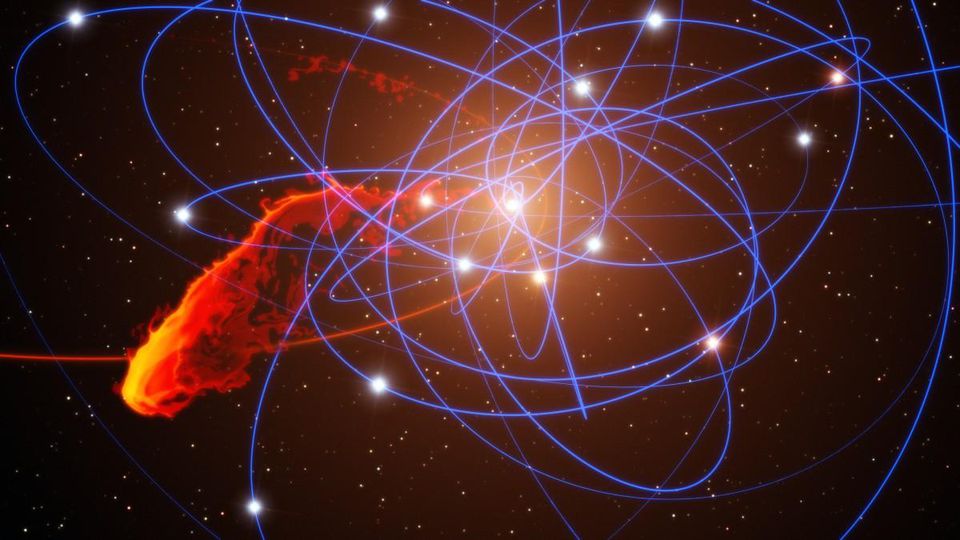 In the centers of galaxies there are stars, gas, dust, and (as we now know) black holes that revolve around and interact with the central supermassive object of the galaxy.
In the centers of galaxies there are stars, gas, dust, and (as we now know) black holes that revolve around and interact with the central supermassive object of the galaxy.This is an amazing discovery, and it was only possible within our Milky Way. Knowing the existence of about 10,000 black holes in the vicinity of our supermassive black hole, we can estimate what happens at the center of each galaxy with a supermassive black hole: thousands and thousands of ordinary black holes moving around it. In the 2030s, the European Space Agency will launch the Advanced Space Dish Antenna using the principle of a laser interferometer (eLISA, formerly LISA), a space detector of gravitational waves with very long arms. Unlike systems with closely spaced bodies of small mass and small circulation period, to which
LIGO is sensitive, eLISA will be the first to detect black holes with a long period of revolution, which are spiraling for a long time and merge with supermassive black holes in the centers of galaxies.
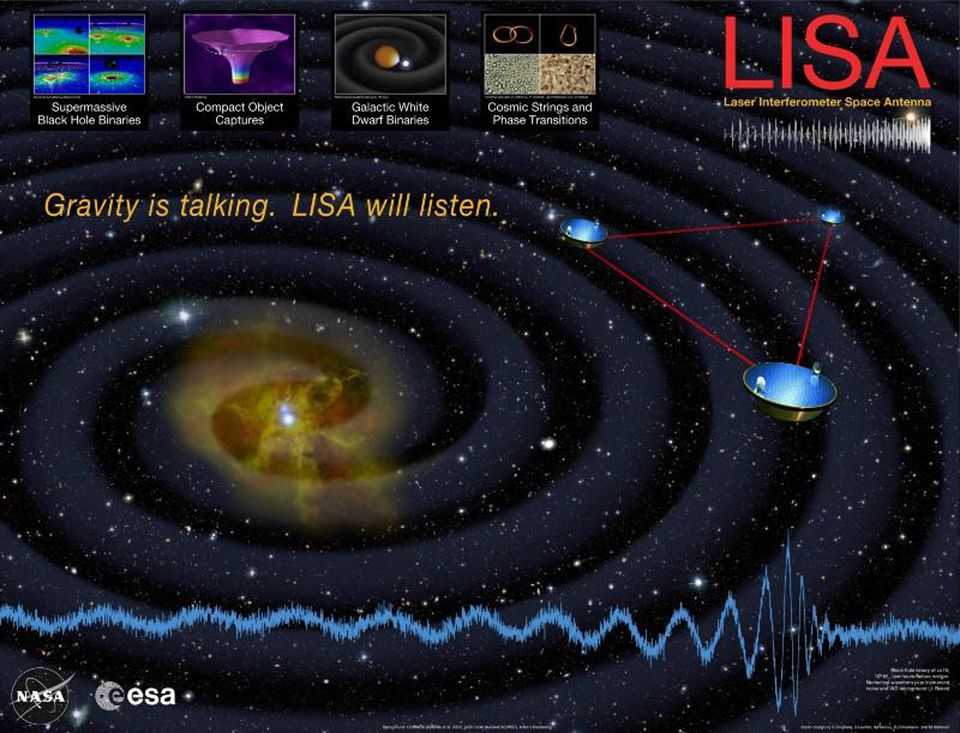 Over the past two years, gravitational waves from the merger of neutron stars and black holes have been discovered on Earth. By creating a gravitational observatory in space, we can raise the sensitivity to a level capable of predicting fusions with supermassive black holes.
Over the past two years, gravitational waves from the merger of neutron stars and black holes have been discovered on Earth. By creating a gravitational observatory in space, we can raise the sensitivity to a level capable of predicting fusions with supermassive black holes.This is an extremely important
study , because it gives us the first real evidence of what eLISA will look for, which motivates us even more to search for such events that, as we already know, can exist. Unlike LIGO black holes, during these convergence processes, we will have weeks, months, or even years of handicap, which will allow us to clearly know when and at what point you need to look to see the merge. This is the first confirmation of the theory of the existence of tens of thousands of black holes around supermassive black holes in the centers of galaxies, and it allows us to better predict how many events connected with them causing gravitational waves can be registered.
All the information we need about this is located in the centers of galaxies, including ours. For the first time, we can be sure that black holes are not cosmic rarities, they exist in huge quantities in every galaxy throughout the Universe.